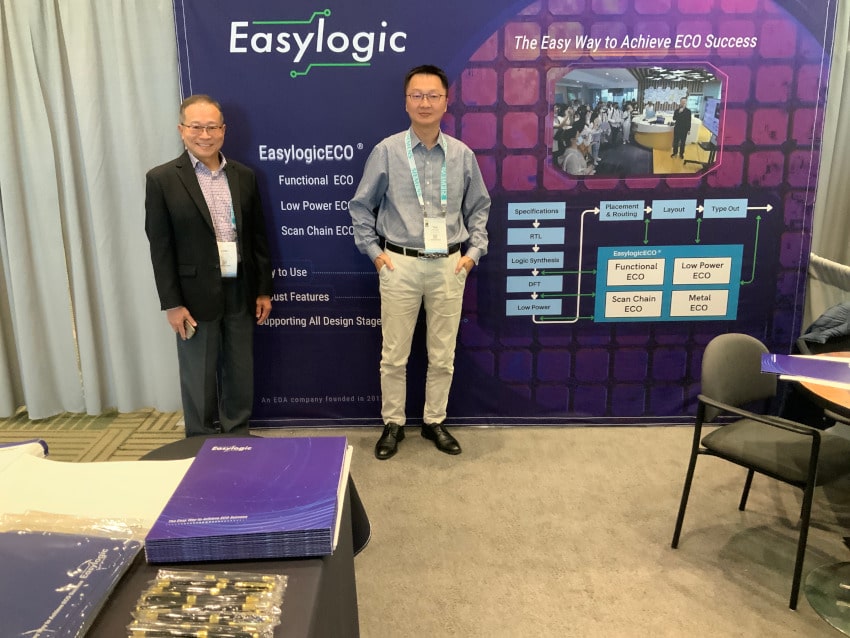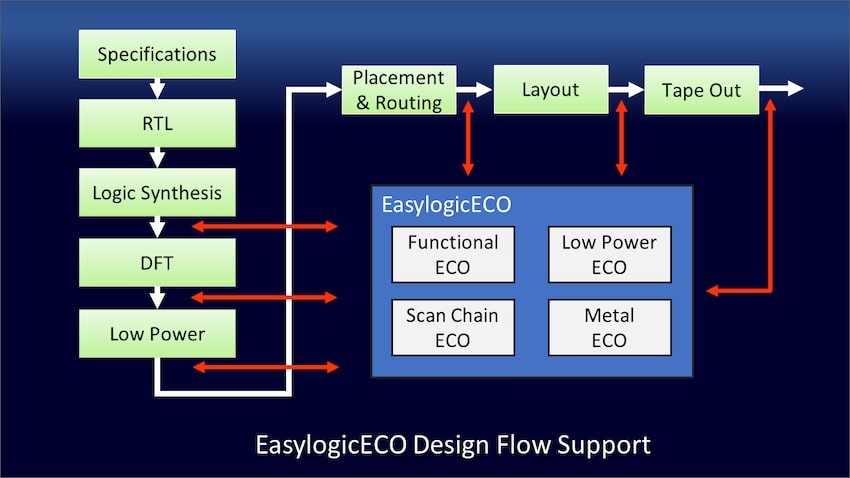I had read a little about Easy-Logic before #60DAC, so this meeting on Wednesday in Moscone West was my first in-person meeting with Jimmy Chen and Kager Tsai to learn about their EDA tools and where they fit into the overall IC design flow. A Functional Engineering Change Order (ECO) is a way to revise an IC design by updating the smallest portion of the circuit, avoiding a complete re-design. An ECO can happen quite late in the design stage, causing project delays or even failures, so minimizing this risk and reducing the time for an ECO is an important goal, one that Easy-Logic has productized in a tool called EasylogicECO.

This EDA tool flow diagram shows each place where EasylogicECO fits in with logic synthesis, DFT, low power insertion, Place & Route, IC layout and tape-out.

Let’s say that your engineering team is coding RTL and they find a bug late in the design cycle, they could make an RTL change and then use the EasylogicECO tool to compare the differences between the two RTL versions, and then implement the ECO changes, where the output is an ECO netlist and the commands to control the Place & Route tools from Cadence or Synopsys.
Another usage example for EasylogicECO is post tape-out where a bug is found or the spec changes, and then you want to do a metal-only ECO change in order to keep mask costs lower.
Easy-Logic is a 10 year old company, based in Hong Kong, and their EasylogicECO tool came out about 5-6 years ago. Most of their customers are in Asia and the names have been kept private, although there are quotes from several companies, like: Sitronix, Phytium, Chipone, Loongson Technology, ASPEED and Erisedtek. Users have designed products in industries for cell phone, HPC, networking, AI, servers, and high-end segments.
EasylogicECO is being used mostly on the advanced nodes, such as 7nm and 10nm, where design sizes can be 5 million instances per block, and functional ECOs are used at the module and block levels. Their tool isn’t really replacing other EDA tools, rather it fits neatly into existing EDA tool flows as shown above. Both Unix and Linux boxes run EasylogicECO, and the run times really depend on the complexity of the design changes. With a traditional methodology it could take 5 days to update a block with 5 million instances, but now with the Easy-Logic approach it can take only 12 hours. This methodology aims to make the smallest patch in the shortest amount of time.
Easy-Logic works at the RTL level. After logic synthesis you basically lose the design hierarchy, which makes it hard to do an ECO. Patents have been issued for the unique approach that EasylogicECO takes by staying at the RTL level.
Engineering teams can quickly evaluate within a day or two this approach from Easy-Logic. They’ve made the tool quite easy to use, so there’s a quick learning curve, as your inputs are just the original RTL, the revised RTL, the original netlist, the synthesized netlist of the revised RTL, and a library.
With 50 people in the company, you can contact an office in Hong Kong, San Jose, Beijing or Taiwan. 2023 was the first year at DAC for the company. Engineers can use this new ECO approach in four use cases:
- Functional ECO
- Low power ECO
- Scan chain ECO
- Metal ECO
Summary
SoC design is a very challenging approach to product development where time is money, and making last-minute changes like ECOs can make or break the success of a project. Easy-Logic has created a methodology to drastically shorten the time it takes for an ECO, while staying at the RTL level. I expect to see high interest in their EasylogicECO tool this year, and more customer success stories by next DAC in 2024.






Comments
There are no comments yet.
You must register or log in to view/post comments.